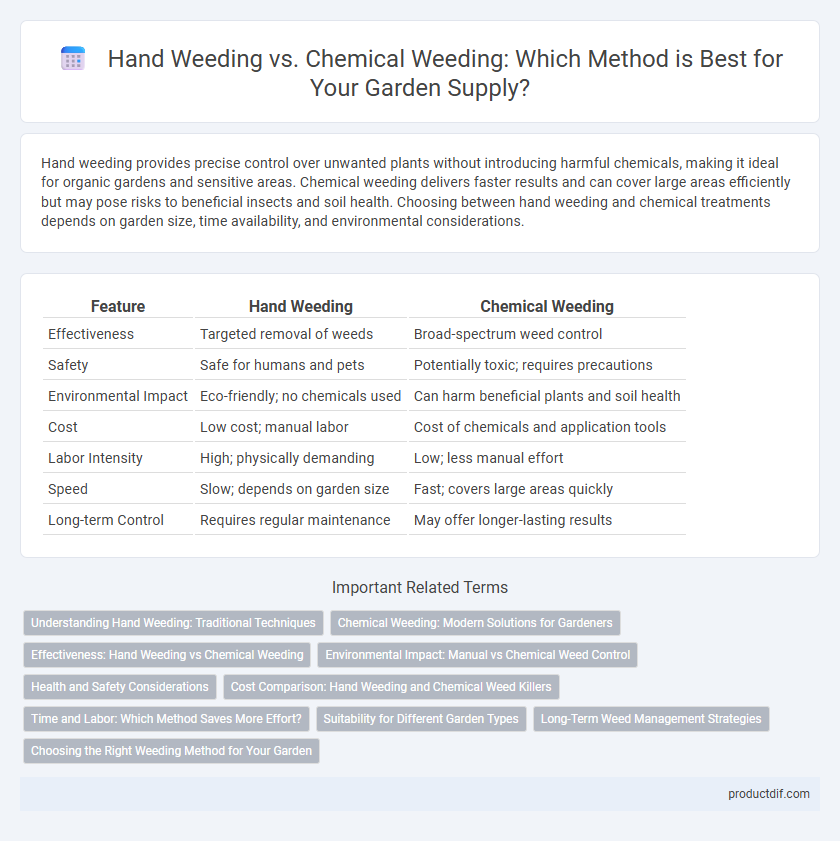Hand weeding provides precise control over unwanted plants without introducing harmful chemicals, making it ideal for organic gardens and sensitive areas. Chemical weeding delivers faster results and can cover large areas efficiently but may pose risks to beneficial insects and soil health. Choosing between hand weeding and chemical treatments depends on garden size, time availability, and environmental considerations.
Table of Comparison
| Feature | Hand Weeding | Chemical Weeding |
|---|---|---|
| Effectiveness | Targeted removal of weeds | Broad-spectrum weed control |
| Safety | Safe for humans and pets | Potentially toxic; requires precautions |
| Environmental Impact | Eco-friendly; no chemicals used | Can harm beneficial plants and soil health |
| Cost | Low cost; manual labor | Cost of chemicals and application tools |
| Labor Intensity | High; physically demanding | Low; less manual effort |
| Speed | Slow; depends on garden size | Fast; covers large areas quickly |
| Long-term Control | Requires regular maintenance | May offer longer-lasting results |
Understanding Hand Weeding: Traditional Techniques
Hand weeding involves the manual removal of unwanted plants using tools like hoes, trowels, or simply by hand, allowing precise targeting of weeds without harming surrounding plants. Traditional techniques prioritize root extraction to prevent regrowth, enhancing soil aeration and promoting healthier garden ecosystems. This method reduces chemical use, supporting organic gardening and minimizing environmental impact while maintaining garden aesthetics and plant health.
Chemical Weeding: Modern Solutions for Gardeners
Chemical weeding offers modern gardeners an efficient and time-saving solution to control invasive weeds with targeted herbicides designed to minimize damage to desired plants. Advances in selective herbicide formulations allow for precise application, reducing environmental impact while maintaining garden health. These innovative products enhance weed management by providing long-lasting effects and adaptability to various garden sizes and plant types.
Effectiveness: Hand Weeding vs Chemical Weeding
Hand weeding provides precise control by physically removing weeds without harming surrounding plants, making it highly effective for small gardens and sensitive crops. Chemical weeding, using herbicides, offers rapid and large-scale weed control but risks damaging nearby vegetation and may lead to chemical resistance. Choosing between methods depends on garden size, weed type, and environmental impact considerations.
Environmental Impact: Manual vs Chemical Weed Control
Manual hand weeding reduces environmental harm by avoiding toxic chemicals that can contaminate soil and water sources, preserving beneficial insects and microbial life. Chemical weeding introduces herbicides that may cause soil degradation, water pollution, and harm to non-target plants and animals. Opting for hand weeding supports sustainable gardening practices by maintaining ecological balance and minimizing chemical residues in the environment.
Health and Safety Considerations
Hand weeding eliminates exposure to harmful chemicals, reducing risks of skin irritation, respiratory issues, and long-term health problems associated with chemical herbicides. Chemical weeding, while efficient, can pose dangers such as accidental poisoning, contamination of soil and water, and adverse effects on beneficial insects and pets. Prioritizing hand weeding promotes a safer gardening environment, especially for families with children or individuals with chemical sensitivities.
Cost Comparison: Hand Weeding and Chemical Weed Killers
Hand weeding requires minimal upfront costs, mainly labor and basic tools, making it economical for small gardens but labor-intensive for larger areas. Chemical weed killers involve higher initial expenses for products and safety equipment but offer quicker application and cover extensive areas efficiently. Over time, chemical methods may incur additional costs due to repeat treatments and potential environmental remediation, whereas hand weeding remains consistent in cost but demands significant time investment.
Time and Labor: Which Method Saves More Effort?
Hand weeding demands significant time and physical labor, especially in larger gardens, as it requires manual removal of weeds by hand or tool. Chemical weeding offers a faster solution by applying herbicides that target weeds broadly, significantly reducing labor but potentially requiring safety precautions and environmental considerations. Choosing between them depends on garden size, labor availability, and priority on eco-friendliness versus efficiency.
Suitability for Different Garden Types
Hand weeding suits small-scale gardens and organic vegetable plots where precision and plant safety are priorities, effectively removing weeds without harming desirable plants. Chemical weeding proves more efficient for large lawns, commercial farms, or extensive flower beds where rapid and broad-spectrum weed control is needed. Selecting the appropriate method depends on garden size, plant sensitivity, and long-term environmental impact concerns.
Long-Term Weed Management Strategies
Hand weeding offers precise removal of weeds, preserving soil health and beneficial organisms, making it an eco-friendly choice for sustainable garden maintenance. Chemical weeding provides rapid control of invasive species but may lead to soil degradation and resistance over time, requiring careful application and monitoring. Integrating both methods with mulch application and crop rotation enhances long-term weed management by reducing reliance on herbicides and promoting healthy soil ecosystems.
Choosing the Right Weeding Method for Your Garden
Hand weeding preserves soil health by minimizing chemical exposure and allowing precise removal of unwanted plants, making it ideal for small or organic gardens. Chemical weeding offers efficiency and time-saving benefits in larger areas, effectively targeting persistent weeds through selective herbicides. Evaluate your garden size, plant sensitivity, and environmental impact to determine the most suitable weeding strategy.
Hand Weeding vs Chemical Weeding Infographic

 productdif.com
productdif.com